Course:FNH200/Assignments/2023/Philadelphia CreamCheese
Appearance
This is the assignment space for Team 1! [1].
Briefly introduce your food products (Optional)
Philadelphia Cream Cheese: Regular vs Light (fat content)
Post pictures (Mandatory)
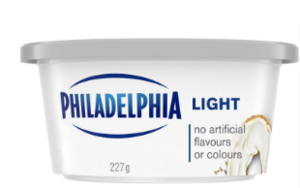
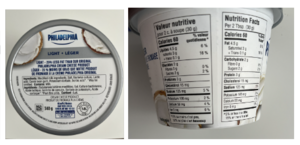
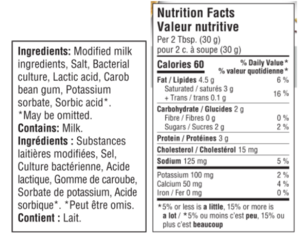
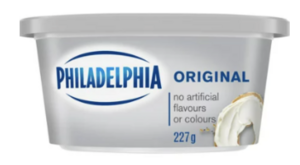

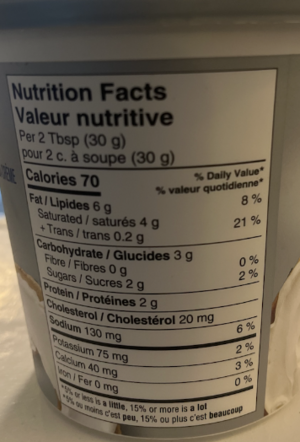
Ingredient lists (4 points)
- Type out the lists of ingredients
- Philadelphia Original cream cheese: Pasteurized milk and cream, salt, guar gum, cheese culture. Contains: milk
- Philadelphia Light cream cheese: Modified milk ingredients, salt, bacterial culture, carob bean gum, potassium sorbate, sorbic acid. Contains: milk
- Identify fat substitutes, sugar substitutes, and/or additives used, if there is any.
- Philadelphia Original cream cheese:
- Guar gum (thickening, stabilizing, binding agent additive)
- Philadelphia Light cream cheese:
- Modified milk ingredients (protein-based fat substitute)
- Sorbic acid (added preservative)
- Potassium sorbate (added preservative)
- Carob bran gum (thickening agent additive)
- Philadelphia Original cream cheese:
- Explain the roles of fat substitutes, sugar substitutes, and/or additives used in terms of the functional properties they contribute to the product
- Philadelphia Original cream cheese:
- Guar gum is a thickening agent, therefore it will enhance the texture while increasing the viscosity of the cream cheese. It will make the cream cheese more creamy and smooth while enhancing the mouthfeel and spreadability . It also functions to impart body to foods. Guar gum as a stabilizer and binding agent will prevent separation of the ingredients, thus they bind the water component and prevent liquid and solid separation. Guar gum binds the fat molecules and maintains the cream cheese in its emulsion state by preventing separation of ingredients. It also binds water and help maintain the moisture and creaminess.
- Philadelphia Light cream cheese:
- Modified milk ingredients (protein-based fat substitute): Due to its ability for microparticulation, it provides the creamy and rich texture of cream cheese that the consumer finds desirable
- Sorbic Acid (Added Preservative): Plays a crucial role in inhibiting the growth of microorganisms, such as bacteria and molds. By doing so, it extends the shelf life of the cream cheese and maintains its freshness and quality over time.
- Potassium Sorbate (Added Preservative): It works in conjunction with sorbic acid to inhibit the growth of microorganisms. Together, these preservatives provide enhanced protection against spoilage, extending the product's shelf life and ensuring its safety for consumption.
- Carob Bean Gum (Thickening Agent Additive): Plays a crucial role in improving the texture and stability of the product. By acting as a thickener, carob bean gum contributes to the smooth and creamy consistency of the cream cheese. It enhances spreadability, improves mouthfeel, and prevents ingredient separation, thus ensuring a desirable and consistent product experience.
- Philadelphia Original cream cheese:
- Compare and contrast the lists of the two products and explain differences.

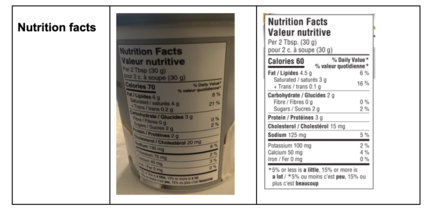
- The light version of the Philadelphia cream cheese is lower in total fat %, saturated fat and cholesterol. More specifically, it makes the claim that it contains 25% less fat than their original product. (Per serving: 4g of saturated fat in the original vs 3g of saturated fat in the light version; in addition to cholesterol of 20mg in the original vs 15mg in the light version). Although no claims have been made regarding the sodium contents and the “light” version refers to the lower fat content, the light cream cheese also contains 5mg less sodium per serving. Since the Philadelphia light cream cheese has modified milk ingredients (protein-based fat substitute) in place of milk and cheese in the original, it contains 1g of extra protein per serving. Lastly, Philadelphia light cream cheese has 10 less Calories when compared to the original.
- The light version is not the lightest version of cream cheese Philadelphia offers. It also has added citric acid and flavoring. Compared to Philadelphia Original Cream Cheese, Philadelphia Light Cream Cheese has more ingredients. The light cream cheese replaces the pasteurized milk and cream of the original cheese with “Modified milk ingredients” which are protein-based fat substitutes. These particles of the protein coagulate and when heat is added to create these modified milk ingredients, it creates a microdispersion. Therefore, this allows for the texture of the protein to be fluid which maintains the creamy texture of cream cheese that the consumer enjoys. Moreover, there are other ingredients added to the light cream cheese such as Carob bean gum, which is added as a thickening agent and an emulsifier which helps to maintain a creamy and enjoyable texture. Sorbic acid is also added to the light cream cheese as a preservative to extend the shelf-life of the product. Lastly, since the light version of the cream cheese uses modified milk ingredients in place of milk and cream, lactic acid is added to maintain the desirable taste of cream cheese, to adjust the pH and to aid in the curdling process and maintain the texture of the cheese. Overall, we can see that the light version of the cream cheese has multiple added ingredients to be able to maintain a desirable taste and texture that the consumer is used to.
Labels (1 points)
- Provide detailed description of the information found on the labels Information found on the label:
- Philadelphia original cream cheese:
- Bilingual labeling: mandatory information are provided in both English and French
- Common name of the food: Cream cheese
- Country of Origin: Canada
- Date marking and Storage instruction: Best before date on front of package and keep refrigerated for storage
- Identity and principal place of business: Kraft Heinz Canada - Toronto,Ontario
- List of ingredients and allergens: (see image above), Allergens: "Contains: Milk" on ingredient list
- Nutritional facts table: (see image above) with serving size, Amount of nutrients per serving in grams or milligrams, and % daily value of nutrients per serving and contains the required information such as (calories, fat (saturated and trans fat), cholesterol, sodium, carbohydrate, fibre, sugar, protein, calcium, iron, and potassium)
- Irradiation: Not found on the item because products are not irradiated
- Net quantity of the food
- Food additives: Clearly identified on the ingredient list
- Sweeteners: None added therefore, not indicated on the ingredient list
- Label for no artificial flavours or colours
- Symbol: (found as MK-dairy on top of the package) which means the cream cheese is kosher certified and is suitable for consumption for those adhering to a kosher diet.
- Philadelphia Light cream cheese:
- Bilingual labeling: mandatory information are provided in both English and French
- Common name of the food: Cream cheese
- Country of Origin: Canada
- Date marking and Storage instruction: Best before date on front of package and keep refrigerated for storage
- Identity and principal place of business: Kraft Heinz Canada - Toronto, Ontario
- List of ingredients and allergens: (see image above), Allergens: "Contains: Milk" on ingredient list
- Nutritional facts table: (see image above) with serving size, Amount of nutrients per serving in grams or milligrams, and % daily value of nutrients per serving and contains the required information such as (calories, fat (saturated and trans fat), cholesterol, sodium, carbohydrate, fibre, sugar, protein, calcium, iron, and potassium)
- Irradiation: Not found on the item because products are not irradiated
- Net quantity of the food
- Food additives: Clearly identified on the ingredient list
- Sweeteners: None added therefore, not indicated on the ingredient list
- Label for no artificial flavours or colours
- Symbol: (found as MK-dairy on the lid of the package) which means the cream cheese is kosher certified and is suitable for consumption for those adhering to a kosher diet.
- Claims and statements: 25% less fat than our original cream cheese product.
- Philadelphia original cream cheese:
- Indicate whether the information complies with the regulatory requirements as outlined in Lesson 04.
- Dairy products are subject to the provisions of the:
- Safe Food for Canadians Act (SFCA)
- Safe Food for Canadians Regulations (SFCR)
- Food and Drugs Act (FDA)
- Food and Drug Regulations (FDR)
- Labeling Requirements:
- https://inspection.canada.ca/food-labels/labelling/industry/dairy/eng/1624983427586/1624983674393
- https://inspection.canada.ca/food-labels/labelling/industry/bilingual-food-labelling/eng/1627499530063/1627499821742
- https://inspection.canada.ca/food-labels/labelling/industry/list-of-ingredients-and-allergens/eng/1628716222800/1628716311275
- “The common name must be declared on the principal display panel of prepackaged food, including dairy products” ✓
- “Ingredients must be declared by an appropriate common name in the list of ingredients [B.01.010(2), FDR]. Dairy ingredient common names include the appropriate standardized or unstandardized common names, as well as the class/collective names "milk ingredients" or "modified milk ingredients" ✓
- “The FDR and SFCR require all prepackaged foods to carry a declaration of the name and principal place of business of the person by or for whom the food was manufactured, prepared, produced, stored, packaged or labelled on the label.”✓
- “The same nutrition labelling requirements and exemptions that apply to all foods also apply to dairy products.”✓
- “”The serving size is based on the edible portion of the food as sold and is closely aligned with the regulated reference amount. The Table of reference amounts for food provides reference amounts for a variety of categories of food, including "Dairy products and substitutes".”✓
- Soft spreadable cheese: The reference amount for soft spreadable cheese is also 30 g. The serving size is expressed by first declaring the household measure (number of tablespoons that is closest in weight in grams to the 30 gram reference amount), followed by the metric measure (which corresponds to the 30 gram reference amount) [for example, "Per 2 tbsp (30 g)"]”✓
- “Mandatory information on consumer prepackaged food must be shown in both official languages, that is, French and English. This includes core labelling requirements, such as common name, and prescribed words or expressions for specific foods” ✓
- “All prepackaged products with more than 1 ingredient must declare their ingredients and components in a list of ingredients” ✓
- “Ingredients must be declared in descending order of proportion by weight, as determined before they are combined to make the food” ✓
- Dairy products are subject to the provisions of the:
Personal Choice (5 points)
Please submit your individual component of this assignment on Canvas to protect your privacy and your personal opinion
References
Please use the Wikipedia reference style. Provide a citation for every sentence, statement, thought, or bit of data not your own, giving the author, year, AND page.
Note: Before writing your wiki article on the UBC Wiki, it may be helpful to review the tips in Wikipedia: Writing better articles.[2]
- ↑ Sample Reference
- ↑ En.wikipedia.org. (2018). Writing better articles. [online] Available at: https://en.wikipedia.org/wiki/Wikipedia:Writing_better_articles [Accessed 18 Jan. 2018].
- creamcheese.com. (2023) Philadelphia Original Cream Cheese. Access from https://www.creamcheese.com/product [Accessed 17 Jul. 2023].
- creamcheese.com. (2023) Philadelphia Light Cream Cheese. Access from https://www.creamcheese.com/product [Accessed 17 Jul. 2023].
- "Guar gum: processing, properties and food applications—A Review". Journal of Food Science and Technology.
- Chan. Judy (2023) FNH 200 Lesson 4. Access from Course:FNH200/Lessons/Lesson 04 [Accessed 17 Jul. 2023].
- Chan. Judy (2023) FNH 200 Lesson 2.2.1.2 Fats and Oils. Access from [Accessed 17 Jul. 2023].
| This Food Science resource was created by Course:FNH200. |
